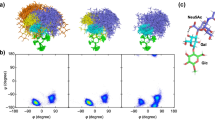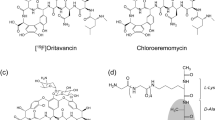Abstract
The oligosaccharide of ganglioside GM1 [Galβ1-3GalNAcβ1-4(NeuAcα2-3)Galβ1-4Glcβ1-1Cer] is the cellular target of two bacterial enterotoxins: the cholera toxin (CT) and the heat-labile toxin of E.coli (LT). We recently reported that the pseudosaccharide 2[Galβ1-3GalNAcβ1-4(NeuAcα2-3)DCCHD] is a high-affinity ligand for CT, and thus a functional mimic of GM1 (Bernardi, A., Checchia, A., Brocca, P., Sonnino, S. and Zuccotto, F., J. Am. Chem. Soc., 121 (1999) 2032–2036). In this paper we describe the design of a second-generation mimic, formally obtained from 2 by inverting the configuration of a single stereocenter, thus transforming a N-acetyl galactosamine into a N-acetyl glucosamine. The design process involved modeling of the free ligand and its LT complex, followed by qualitative and quantitative comparison with the corresponding structures of 2. The protocol employed relied on both conformational search and molecular dynamics methodologies to account for the flexibility of both the ligand and the protein receptor. The conformational search of the LT:inhibitor complex showed that, compared to 2, the new compound can insert one more hydroxy group within the protein binding site. Molecular dynamics simulations showed that, in turn, this may trigger a series of rearrangements and reorientations of side chains and crystallographic water molecules in the toxin, leading to new H-bond contacts which may result in enhanced affinity of the new inhibitor. FEP calculations were performed by mutating the structure of 2 in solution and in the protein complex, and the prediction was made that the second-generation mimic should be a stronger binder than its parent compound.
Similar content being viewed by others
References
Sears, P. and Wong, C.-H., Angew. Chem. Int. Ed., 38 (1999) 2300–2324, and references therein.
Davis, A.P. and Wareham, R.S., Angew. Chem. Int. Ed., 38 (1999) 2978–2996, and references therein.
For a discussion, see Rubinstenn, G., Sinay, P. and Berthault, P., J. Phys. Chem. A, 101 (1997) 2536–2540.
Cooke, R.M., Hale, R.S., Lister, S.G., Shah, G. and Weir, M.P., Biochemistry, 33 (1994) 10591–10596.
Scheffler, K., Ernst, B., Katopodis, A., Magnani, J.L., Wang, W.T., Weisemann, R. and Peters, T., Angew. Chem. Int. Ed., 34 (1995) 1841–1844.
Poppe, L., Brown, G.S., Philo, J.S., Nikrad, P.V. and Shah, B.H., J. Am. Chem. Soc., 119 (1997) 1727–1736.
Harris, R., Kiddle, G.R., Field, R.A., Milton, M.J., Ernst, B., Magnani, J.L. and Homans, S.W., J. Am. Chem. Soc., 121 (1999) 2546–2551.
Bundle, D.R. and Milton, M.J., J. Am. Chem. Soc., 120 (1998) 10547–10548.
Woods, R.J., Glycoconj. J., 15 (1998) 209–216.
Bernardi, A., Raimondi, L. and Zuccotto, F., J. Med. Chem., 40 (1997) 1855–1862.
Minke, W.E., Diller, D.J., Hol, W.G.J. and Verlinde, C.L.M.J., J. Med. Chem., 42 (1999) 1778–1788.
Pathiaseril, A. and Woods, R.J., J. Am. Chem. Soc. 122 (2000) 331–338.
Spangler, B.D., Microbiol. Rev., 56 (1992) 622–647, and references therein.
Lanne, B., Schierbeck, B. and Ångström, J., J. Biochem., 126 (1999) 226–234.
Lanne, B., Schierbeck, B. and Karlsson, K.A., J. Biochem., 116 (1994) 1269–1274.
Ångström, J., Tenenberg, S. and Karlsson, K.A., Proc. Natl. Acad. Sci. USA, 91 (1994) 11859–11863.
Schengrund, C.-L. and Ringler, N.J., J. Biol. Chem., 264 (1989) 13233–13237.
Schön, A. and Freire, E., Biochem., 28 (1989) 5019–5024.
Fukuta, S., Magnani, J.L., Twiddy, E.M., Holmes, R.K. and Ginsburg, V., Infect.Immun., 56 (1988) 1748–1753.
Merritt, E.A., Sarfaty, S., v.d.Akker, F., L'Hoir, C., Martial, J.A. and Hol, W.G.J., Protein Sci., 3 (1994) 166–175.
Merritt, E.A., Sarfaty, S., Jobling, M.G., Chang, T., Holmes, R.K., Hirst, T.R. and Hol, W.G.J., Protein Sci., 6 (1997) 1516–1528.
Merritt, E.A. and Hol, W.G.J., Curr. Opin. Struct. Biol., 5 (1995) 165–171, and references therein.
Acquotti, D., Poppe, L., Dabrowski, J., v.d.Lieth, C.-W., Sonnino, S. and Tettamanti, G., J. Am. Chem. Soc., 112 (1990) 7772–7778.
Bernardi, A., Checchia, A., Brocca, P., Sonnino, S. and Zuccotto, F., J. Am. Chem. Soc., 121 (1999) 2032–2036.
Mohamadi, F., Richards, N.G.J., Guida, W.C., Liskamp, R., Lipton, M., Caufield, C., Chang, G., Hendrickson, T. and Still, W.C., J. Comp. Chem., 11 (1990) 440–467.
Bernardi, A. and Raimondi, L., J. Org. Chem., 60 (1995) 3370–3377.
Still, W.C., Tempzyk, A., Hawley, R. and Hendrickson, T., J. Am. Chem. Soc., 112 (1990) 6127–6129.
Jorgensen, W.L., Chandrasekhar, J., Madura, J., Impey, R.W. and Klein, M.L., J. Chem. Phys., 79 (1983) 926.
Dixon, S.L. and Merz, K.M. Jr., J. Chem. Phys., 107 (1997) 879–893.
Woods, R.J., Dwek, R.A., Edge, C.J. and Frasier-Reid, B.J.P.C., J. Phys. Chem., 99 (1995) 3832–3846.
Case, D.A., Pearlman, D.A., Caldwell, J.C., Cheatham, T.E.I., Ross, W.S., Simmerling, C.L., Darden, T.A., Merz, K.M. Jr., Stanton, R.V., Cheng, A.L., Vincent, J.J., Crowley, M., Ferguson, D.M., Radmer, R.J., Seibel, G.L., Singh, U.C., Weiner, P. and Kollman, P.A., AMBER 5.0; University of California, San Francisco, (1997).
van Gunsteren, W.F. and Berendsen, H.J.C., Mol. Phys., 34 (1977) 1311.
Berendsen, H.J.C., Potsma, J.P.M., van Gunsteren, W.F., DiNola, A.D. and Haak, J.R., J. Chem. Phys., 81 (1984) 3684–3690.
Cheng, A. and Merz, K.M. Jr., J. Phys. Chem., 100 (1996) 1927–1937.
Smith, P.E. and Pettitt, B.M., J. Chem. Phys., 105 (1996) 4289–4293.
Merz, K.M. Jr., Murcko, M.A. and Kollman, P.A., J. Am. Chem. Soc., 113 (1991) 4484–4490.
Colombo, G., Toba, S. and Merz, K.M. Jr., J. Am. Chem. Soc., 121 (1999) 3486–3493.
Toba, S., Damodaran, K.V. and Merz, K.M. Jr, J.Med.Chem. 42, (1999), 1225–1234.
Spellmeyer, D.C., Fox, T., Caldwell, J.W. and Kollman, P.A., J. Am. Chem. Soc., 117 (1995) 5179–5197.
Weiner, S.J., Kollman, P.A., Case, D.A., Singh, U.C., Ghio, C., Alagona, G., Profeta, S. and Weiner, P., J. Am. Chem. Soc., 106 (1984) 765–784.
Massova, I. and Kollman, P.A., J. Am. Chem. Soc., 121 (1999) 8133–8143.
Singh, S.B. and Kollman, P.A., J. Am. Chem. Soc., 121 (1999) 3267–3271.
Minke, W.E., Roach, C., Hol, W.G.J. and Verlinde, C.L.M.J., Biochemistry, 38 (1999) 5684–5692.
Colombo, G. and Merz, K.M. Jr., J. Am. Chem. Soc., 121 (1999) 6895–6903.
Different binding modes to the same protein have been calculated for diastereomeric monosaccharides binding to the mannose-binding protein: Liang, G., Schmidt, R.K., Yu, H.-A., Cumming, D.A. and Brady, J.W., J. Phys. Chem., 100 (1996) 2528–2534.
Mangoni, M., Roccatano, D. and Di Nola, A., Proteins, 35, (1999) 153–162.
Wang, J., Kollman, P.A. and Kuntz, I.D., Proteins, 35, (1999) 1–19.
Author information
Authors and Affiliations
Rights and permissions
About this article
Cite this article
Bernardi, A., Galgano, M., Belvisi, L. et al. Simulation of carbohydrate-protein interactions: Computer-aided design of a second generation GM1 mimic. J Comput Aided Mol Des 15, 117–128 (2001). https://doi.org/10.1023/A:1008145830153
Issue Date:
DOI: https://doi.org/10.1023/A:1008145830153




